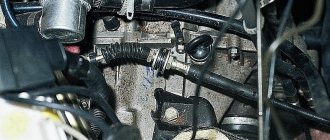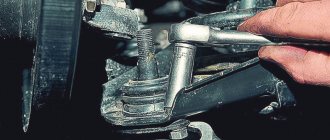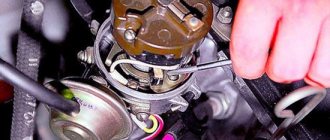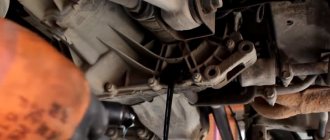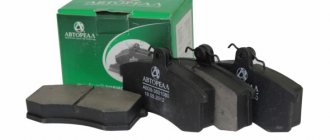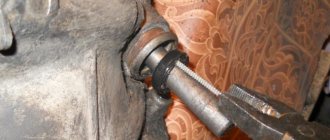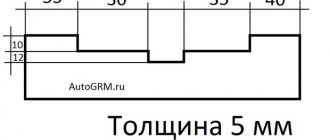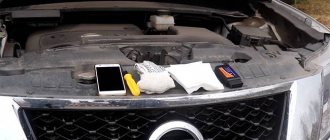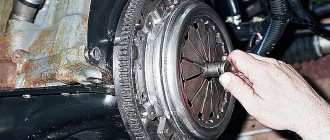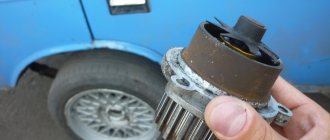Car repair is a rather complex and time-consuming operation, and it is usually entrusted to car service professionals. Certain machine components do not generally require dismantling and repair by the driver in a garage. However, repair services are becoming more expensive, and vehicles break down more and more every year. Owners of products from the domestic automobile industry are not yet deprived of the opportunity to troubleshoot problems in their “iron horse” on their own. Transmission breakdown is one of the common problems that cause headaches for the owner of VAZ cars. Today we will talk about how to remove the box on a VAZ 2110, diagnose it and carry out feasible repairs.
VAZ 2110 gearbox device
The Volzhsky Automobile Plant's 10th series vehicles are equipped with a five-speed manual gearbox. It is two-shaft, has five gears for forward movement and one reverse gear for reverse. The main gear, differential and the gearbox itself are combined in one housing. When connecting the crankcase to the cover, it is possible to seal it with a gasket or sealant that is resistant to gasoline and oil.
The two-shaft system is represented by a primary and secondary shaft. The first is a block of driving gears, the second contains driven gears that provide forward movement. The two groups of gears are in constant mesh. The secondary shaft parts can be removed for replacement or repair.
The secondary shaft is made empty inside to lighten the weight of the structure. At the locations of the gears there are circular grooves that ensure the supply of lubricant to the surface of the shaft during operation. The rotation of the fifth gear gear is carried out through the bushing. The shaft splines are used to install synchronizer hubs. The shafts themselves are installed in the box body on bearings - a pair of roller bearings on one side and a pair of ball bearings on the other.
The differential uses two satellites. The pretension of the bearings in it can be adjusted by changing a special ring from thick to more or less thin. This ring can be found under the outer differential bearing cover. The speed sensor is connected to a plastic gear located on the gearbox housing, which, in turn, is driven by the drive gear on the differential housing.
VAZ 2110 gearbox design: 1- clutch release bearing; 2 — guide sleeve of the clutch release bearing; 3 - main gear drive gear; 4 — roller bearing of the secondary shaft; 5 - oil sump; 6 — satellite axis; 7 — speedometer drive gear; 8 — axle gear; 9 — differential box; 10 — satellite; 11 — clutch housing; 12 — driven gear of the main gear; 13 — adjusting ring; 14 — tapered roller bearing of the differential; 15 — axle shaft seal; 16 — driven gear of the 1st gear of the secondary shaft; 17 — synchronizer for 1st and 2nd gears; 18 — driven gear of the second gear of the secondary shaft; 19 — driven gear of the third gear of the secondary shaft; 20 — synchronizer for 3rd and 4th gears; 21 — driven gear of the fourth gear of the secondary shaft; 22 — ball bearing of the secondary shaft; 23 — driven gear V of the secondary shaft transmission; 24 — 5th gear synchronizer; 25 - secondary shaft; 26 — rear cover of the gearbox housing; 27 — drive gear of the 5th gear; 28 — ball bearing of the input shaft; 29 — input shaft; 30 — gearbox housing; 31 — roller bearing of the input shaft; 32 — input shaft oil seal; 33 - breather
When driving on a bumpy road, the engine experiences vibrations, which, if the rubber dampers are worn out or sagging, can lead to displacement of the gearbox shafts. This can result in unpredictable transmission disengagement when the gears on the two shafts become disengaged. To compensate for such vibrations, a reaction rod is provided in the connection between the gearshift handle support and the gearbox housing. It is equipped with a rubber gasket to dampen vibration from the engine, which causes the gearshift lever to shake.
You can read more about the clutch design in a car here:
You can find out how much oil is in the gearbox by checking the dipstick. According to factory standards, the gearbox holds 3.5 liters. If the oil level drops, it is necessary to add it, otherwise accelerated wear of the gears can lead to breakdown. Technical regulations require routine oil changes every 90 thousand kilometers.
Features of power plants
The VAZ 2112 (Lada) car can be equipped with 16 valve power units, which have a volume of 1.5 liters, and the power reaches 93 horsepower. The power supply system of this car is injection. It is recommended to use AI-95 gasoline. In the urban cycle, it consumes about 10 liters per 100 km. The VAZ gearbox in this case is mechanical.
Cars with a 1.6-liter engine, which is equipped with a manual transmission (5 speed) and produces 89 horsepower, have become widespread. VAZ is less demanding on fuel quality, so AI-92 can be filled here.
Manual transmission diagram Gear shift diagram
Malfunctions
Every car owner with experience begins to feel a malfunction in the car’s gearbox based on characteristic signs. Most gearbox breakdowns are associated with wear of rubbing parts, because they experience constant significant load while driving. However, such wear rarely reaches a critical state immediately. This is usually a gradual process, which is why a novice driver is always advised to learn to “listen” to the car. The sooner you notice a problem, diagnose it accurately and fix it, the less repair work will need to be done and the less it will cost.
It is recommended to regularly check where the vehicle is parked for stains to monitor leakage of technical fluids.
You can classify signs that indicate breakdowns as follows:
- Noise in manual transmission. This may be a crackling, knocking, rustling, grinding, as well as beating of the gear shift lever. Knocking can occur during different phases of the box's operation. An experienced motorist can even determine from such a rustle which parts are at risk. For example, noise when a car turns into a turn indicates wear on the differential gears.
- Gears are hard to engage. In addition to the wear of parts of the gearbox itself, the malfunction may also lie in the clutch. In addition, there is a risk of deformation of the gearshift control rods. Remember that plastic parts break much more easily than metal parts.
- Spontaneous “dropping out” of the gear while driving. Over time, gear teeth become chipped and worn down, becoming shorter. The slightest vibration disengages them and the transmission “flies out”. In this case, it is also necessary to check the engine mounting.
- A sharp click and loss of smoothness when changing gears. If the clutch is working properly, then the cause of such a problem is most often the failure of the synchronizer blocking ring of the desired gear.
- The box “eats” a lot of oil. Increased oil consumption is primarily a leak. It can occur through a depressurized crankcase, as well as worn oil seals, which are located on almost any hole in the box body.
Malfunctions also include rattling of the gearshift lever. More information can be found here:
Most of these faults cannot be solved in any other way than by replacing worn parts. The gearbox is close to the center of mass of the car and breaks down much less often than the engine or suspension.
Such gear failures cannot be eliminated in any way except by replacing the unit
Therefore, if something happens to it, repairs will definitely be required. In order to find out which wear parts cause noise or interfere with the smooth movement of the lever, you need to remove and disassemble the gearbox.
Instructions for removing the gearbox
The procedure for removing the gearbox is labor-intensive and time-consuming. It’s easier to replace it with a VAZ 2110 by visiting a car service center, but you can do it yourself.
Tools
To carry out the procedure, you will need tools consisting of:
- a set of wrenches, socket or open-end wrenches;
- set of heads with extensions;
- flat screwdriver;
- mounts;
- pliers;
- jack;
- clean rags.
In addition, you should prepare a container to drain the used oil. You can use a plastic 5 liter bottle.
Tools should be prepared in advance so that they are nearby while working.
Sequencing
To remove the gearbox, you need access to the underbody of the car, so it needs to be lifted. This can be done using a lift, or driving the car onto an overpass or inspection groove.
Since the removal work is quite complicated, you will need an assistant.
The following video demonstrates replacing the clutch, the first step of which is removing the gearbox.
Oil condition monitoring
When draining old used oil, pay attention to it: there should be no metal shavings or other foreign inclusions in the liquid. Their presence indicates improper operation of the gearbox or the use of low-quality oil.
If you find pieces of metal in the oil, your box is already damaged and its days are numbered. In this case, you need to contact a service center or try to fill in new grease and drive it for about a week, and then drain it and see if new debris appears. If everything is in order, you can continue to operate the car, but after a few months repeat the procedure just in case.
To ensure that the VAZ 2114 gearbox serves you for a long time, learn how to use it correctly. Do not shift gears very sharply, as many motorists do, so that the engine has time to slow down and no shocks occur when shifting, causing damage to the unit.
Sources
- https://spike.su/index.php/Disassembling-the-gearbox-eliminating-rattling-knob-gearbox-and-installing-the-cardan-link-gearbox-from-Kalina-VAZ-2113-2114-2115.html
- https://driving24.ru/kak-pomenyat-maslo-v-korobke-vaz-2114-samostoyatelno/
Preparatory work
Handbrake + shoes for rear wheels = safety first
Before you begin dismantling the gearbox, ensure that the car is level and stable, and make sure that wheel chocks are installed under the rear wheels. Raise the handbrake lever as high as possible.
Removing the gearbox on a VAZ-2112: step-by-step procedure
First of all, open the hood and turn off the power from the battery. Next, we unhook the clutch cable from the fork, removing it from the place of fixation on the gearbox itself.
Disconnect the connector from the speed sensor.
The next step is to drain the transmission oil from the crankcase; to do this, unscrew the drain plug and prepare a pre-prepared container with a total volume of at least 5 liters. Remember how much oil you drained from the gearbox.
Then we unscrew the bolt that secures the ignition module to the gearbox itself, and then two more bolts that serve to fix the gearbox itself to the car engine.
We disconnect the connector located at the bottom of the gearbox, which serves to transmit information to the reverse sensor.
We unscrew the two bolts that secure the jet thrust.
Next, we loosen the tightening torque of the clamp securing the fastening of the gear lever rod, then it must be moved back, relative to the gear selection hinge rod.
Next, it is necessary to remove the internal CV joints from their fixation points (constant velocity joint - approx.)
At the same time, please note that a plug must be inserted in place of the left CV joint to prevent the drive from turning, and the right joint does not need to be removed completely, just move it to the side and simply hang it on a rope.
To make further work on dismantling the gearbox easier, it is necessary to loosen the bolts securing the ball joint to the steering knuckle.
Next, unscrew the nut that secures the lower right side of the gearbox. Please note that on injection models, a special bracket is mounted under this nut, which must also be removed from its mounting location. If necessary, the nut (indicated by the red arrow - approx.) can be loosened. We unscrew the 3 nuts that hold the clutch cover to the gearbox housing.
Then remove the bolt securing the gearbox to the engine on the left side
At this stage, make sure that stops, a jack, or other supporting device are installed under the gearbox. We raise the engine a little; in this case, it is very convenient to use a second jack when working on the inspection hole. Next, unscrew the nut securing the engine mount on the left side. At the same time, inspect its condition and if replacement is required, read this article carefully. Next, we unscrew the two nuts of the “cushion” from the rear side, while first dismantling its front part, after which we move on to its rear support.
To learn how to easily remove all engine mounts, read this article. When dismantling this support, unscrewing the nut and bolt, you should fix them with two keys in order to avoid turning.
When all the bolts are unscrewed and the gearbox is firmly fixed to its fixing device or jack, insert a screwdriver with a thick tip directly between the clutch housing and the cylinder block.
Move the box until it comes off the guide bushings, and be sure to use an assistant to hold it from accidentally tipping over. Carry out the dismantling process until the input shaft comes out of the clutch.
Now that this work is completed, you can continue with the next step depending on your goals.
Transmission fluid selection
Practice shows that factory transmission oil is of low quality, so immediately after purchasing a car, a whine is noticed in the operation of the gearbox. To extend the service life of the gearbox and also reduce its noise, it is recommended to replace the gear oil with a higher quality one.
Which manufacturer is better to choose?
Opinions about transmission manufacturers differ greatly; some support domestic manufacturers, while others, on the contrary, rely on the recommendations of well-known car factories. Which gear oil is better, and which one you choose, depends only on your personal point of view and the ability to evaluate and listen to the advice of experts.
- Liqui Moly;
- Castrol;
- Mobil.
The AvtoVAZ fan club supports both a selection of reputable brands and Russian manufacturers, for example, Rosneftekhim, Lukoil, Rosneft. In any case, the choice of high-quality gear oil for the VAZ-2112 gearbox occurs through a long selection process, where each car owner goes through a long journey of testing and experimentation.
